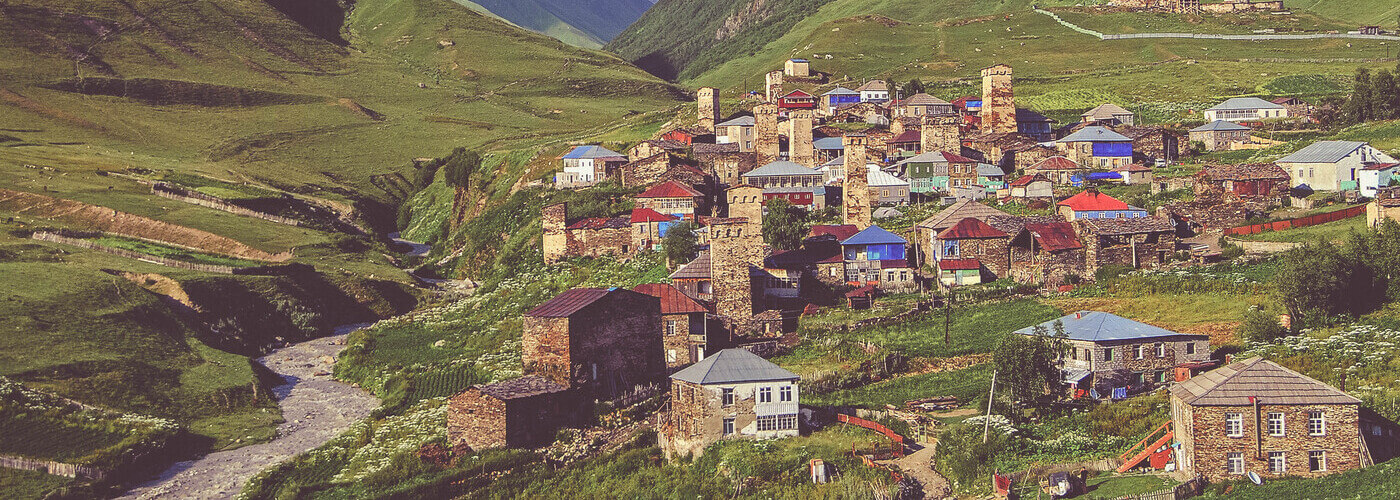- 4
- 1
- 2
- 3
- 3
- 2
- 2
- 2
- 4
- 2
- 4
- 4
- 1
- 1
- 1
- 1
- 1
- 1
- 1
- 1
- 1
- 3
- 3
- 1
- 3
- 3
- 3
Ushguli
Svaneti, Georgia

Ushguli is a village community in the Georgian region of Svaneti. The village, which consists of four smaller villages, lies in the mountains of the Great Caucasus and is a UNESCO World Heritage Site, with its defense towers.
Located at an altitude of 2,086 to 2,200 meters, Ushguli is one of the highest villages in Europe. It consists of the four villages Murqmeli, Chashashi, Chvibiani, and Shibiani, which line up along the river for a distance of two kilometers. From Shibiani, the highest village, it is only eight kilometers from the Shkhara Glacier. The route is very popular with hikers.
The approximately 250 inhabitants of Ushguli make their living from agriculture and more and more from tourism. Various families have converted their houses into simple guesthouses, offering their guests rooms and cooking for them.
Svan towers are up to 25 meters high
The tourists come primarily because of the old houses with their Svan defense towers, which have been part of the UNESCO world cultural heritage since 1996. The oldest towers date back to the 8th and 9th centuries. However, there are also towers that are just over 200 years old. In the past, the Svanetian fortified towers fulfilled several tasks: On the one hand, they served the families as living space, on the other hand as protection – partly against unpleasant intruders, but also against avalanches and other whims of nature.
The fortified towers were mostly attached directly to the house, but there were also free-standing towers. The house in Svaneti is called Machubi. On the ground floor, there was always a fireplace, which served the families as a cooking place, living space, and of course as heating. The livestock was kept in the same room, so it was also stable. The hay was stored on the upper floor.
The massive tower, built of stone and 20 to 25 meters high, had several floors. Some towers had five or six floors, but most had three. The Svans used to store their food on the ground floor. This room usually had neither doors nor windows – for security reasons. They withdrew to the second floor when there was danger. There (or on the third floor) was also the entrance to the tower, which could only be entered via a ladder that was lowered. On the top floor, covered with a slate roof, were the balustrades with embrasures on both sides, from which the enemies could be observed and attacked if they came too close to the houses.
What else there is to see in Ushguli?
Although tourism is becoming more and more popular in Ushguli, the village is more authentic and pristine than the capital Mestia, which lies further down in the valley. The guesthouses are simple, the roads unpaved and the village infrastructure comparatively simple and modest. In Ushguli, locals, tourists, and many animals cross paths: cattle, cows, horses, pigs, dogs, and chickens move peacefully and freely in the village. A little tip: Get up early in the morning and walk through Ushguli when there are no people on the way. The village then shows its authentic side.
The Lamaria Monastery
Just behind the upper end of Ushguli, on a hill, there is the small Lamaria Monastery, built in the 11th century. The locals believe that Queen Tamar is buried there. The monastery is in operation and can be visited. Not far from the monastery Lamaria there is also the church St. Georg Jgrag.
Ethnographic Museum Ushguli
When the weather isn’t that good, it is worth visiting the Ethnographic Museum in Ushguli. The museum is located in an old and well-preserved Svan house from the 16th century.
In the small museum, you will see numerous artifacts from the Svan’s long history. They are the evidence of old traditions, bloody conflicts, and a life full of privation in the remoteness of the Greater Caucasus mountains. You will find furniture, arts and crafts, everyday life objects, crosses, icons, and much more. The oldest items date back to the 12th century.
The Svans and their language
In addition to Georgian, the people in Svaneti have their own language called Svan. As Georgian, Laz, and Megrelian, Svan is also part of the South Caucasian language family. The main differences are: In Svan, there are more vowels and the Svan is not a literary language. The Svans use the Georgian alphabet (Mkhedruli) to write.
There are between 20,000 and 30,000 Svan speakers, whereof the most live in Svaneti. The Svan language is widely used at home and with friends. The lingua franca in Svaneti is Georgian.

